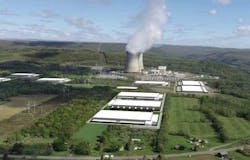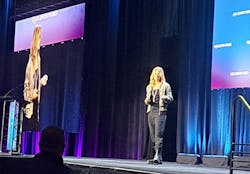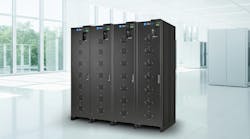The Internet is entering an era of gigawatt-scale data center campuses to power artificial intelligence (AI), according to developers and industry groups, who say this approach provides the best opportunity to support AI workloads with renewable energy.
Hyperscale tech companies are already seeking sites for campuses that can support a gigawatt of electric power capacity, equal to 1,000 megawatts or 1 billion watts, according to speakers at last week’s Data Center World conference.
“Data centers are going to be very different,” said Ali Fenn, President of data center developer Lancium, in a keynote at DCW. “They could be 1 gigawatt to 2 gigawatts, potentially. All of the requirements I’ve been discussing are 1 gigawatt and 2 gigawatts. The sheer size of what we’re talking about is unprecedented, with a much bigger physical footprint.”
Real estate industry sources affirm that tech titans are actively discussing gigawatt-scale campuses, citing the massive compute needed to support AI models, as well as the desire to find locations that can support many years of future growth.
Lancium is planning 5 new campuses with 2.5 gigawatts of power available, and plans to scale to 6 gigawatts, said Fenn.
Fenn sees these megascale campuses as an opportunity for the growth of digital services to enable new energy technologies and collaborate with utilities and grid operators. This includes providing “responsive” loads that can balance grid demand, making it easier to add solar and wind power, which are sustainable but intermittent.
Meanwhile, Amazon Web Services recently bought a data center co-located with a nuclear power facility, where it hopes to gradually deploy up to 960 megawatts of cloud capacity.
A Vision for ‘Clean Energy Parks’
These MegaCampuses represent the next chapter for largest players in cloud computing, who operate hyperscale campuses that concentrate massive amounts of computing. These data center hubs enable companies to rapidly add server capacity and electric power, creating economies of scale. As AI boosts demand for compute power, these campuses are being super-sized.
In our 2024 Forecast we noted that site selection will “optimize for Green MegaCampuses.” This aligns with the vision of the Infrastructure Masons, an industry group that last week called for the creation of “clean energy parks” to support up to 10 gigawatts of data center capacity with renewable energy and next-generation approaches to sustainability.
These could include energy storage, hydrogen fuel cells, microgrids, enhanced geothermal energy, renewable generator fuel like hydrotreated vegetable oil (HVO) to replace diesel, and eventually small modular reactors and fusion.
“Clean energy zones could enable accelerated growth of Digital Infrastructure across the established markets of North America and Europe and allow the emerging markets of Africa, Latin America and India to scale faster,” the iMasons said in their 2024 annual report, adding that success will “require coordination between the Digital Infrastructure industry and governments, power and water utilities, community leaders, adjacent industries and anyone else who wants to see the digital economy grow in the digital age.”
That’s not an easy task. Both Lancium and the iMasons seek to build on a vision for “data center cities” unveiled three years ago by Quantum Loophole, which says it is still about a year away from bringing fiber and power to its 2,100-acre campus in Frederick, Maryland.
Solving the Gigawatt-Scale Power Equation
The planning for gigawatt campuses highlights the tension between the rapid advance of AI-powered digital transformation, and the slower approach taken by utilities and grid operators.
“The grid is the most complex machine in the world,” said Allan Schurr, Chief Commercial Officer of microgrid specialist Enchanted Rock. “They’re pretty conservative about making changes. That deliberate approach has served them well, historically.”
A key challenge is expanding transmission networks, which are the current bottleneck in power-constrained markets like Northern Virginia. This process typically takes years, typically involving public utility commissions, utilities and community groups across multiple states.
“(Transmission) construction takes a long time,” said Marcisha Adams, the VP for Power and Utilities at EdgeCore Digital Infrastructure.
Adams was part of a DCW session on new collaboration frameworks between data centers and utilities, and said the two industries must gain better understanding of their respective goals and challenges.
“There is power out there,” said Adams. “But when data centers and other large users ask for a gigawatt, that’s not just sitting on the system. There’s power, but you can’t use contracted power. That’s why we have the situation we have now."
“Everyone has to get together and get creative to work it out,” said Adams. “A lot of what we have to do is get out of our comfort zones and go into new markets.”
That’s the thesis driving the new MegaCampuses, said panelist Michael Donohue, Managing Director of Business Development at Cumulus Data and chair of the Power Working Group for the Infrastructure Masons. The idea is to “rearrange the puzzle pieces” to feature a hyperscale campus, microgrid, on-site generation, energy storage and the ability to integrate power back into the grid.
“There’s been more discussion of working with RTOs (regional transmission organizations) and ISOs (independent system operators) about creating these huge hyperscale campuses far away from cities,” said Donohue. “We do need more load, but probably in new, non-traditional places. It’s the only way to add more renewables back onto the grid.”
Regulatory Clarity for Maryland MegaCampus
Creating megacampuses in new markets isn’t always simple, as seen in the pioneering work of Quantum Loophole to provide access to the huge cloud cluster in Northern Virginia from across the Potomac in Maryland. The project taps the massive power infrastructure for the former Alcoa Eastalco Works smelting plant in Frederick County.
Last year Aligned Data Centers canceled a planned development at the Quantum Loophole campus after the Maryland Public Service Commission limited the company to 70 MWs of generator capacity, rather than the 168 generators Aligned had requested.
The Maryland legislature has passed legislation to clarify that data centers and hospitals using backup power units were not “generating stations,” a position adopted by the state utility commission in the Aligned case. The bill is awaiting a signature from Gov. Wes Moore, who has expressed support for the bill.
That would clear the path for Quantum Loophole, which has invested in tunneling under the Potomac to create a fiber connection to Data Center Alley in Ashburn. The company expects the fiber loop to be completed by March of 2025, said Rich Paul-Hus, co-founder and SVP of Quantum Loophole. The primary campus substation is expected to come online around that same time.
The first customer is Rowan Digital, which is planning a 300-megawatt campus in Frederick that could grow to 450 MWs.
“There’s been tremendous interest, but it’s taken time to deal with challenges,” said Paul-Hus. “Our job is to clear the hurdles for those customers.”
Another high-profile MegaCampus is also facing hurdles. The 2,100-acre Prince William Digital Gateway in Prince William County, Virginia has faced fierce opposition from community groups concerned about its environmental impact and proximity to a Civil War battlefield. After gaining key rezoning approvals, developers Compass Datacenters and QTS Data Centers hope to eventually build up to 23 million square feet of data centers on the campus.
Load Balancing at Utility Scale
In her keynote at DCW, Fenn said that selecting sites with the right location and energy profile is the key to solving data center capacity challenges.
“Bringing load to the generation will be essential,” she said. “The opportunity here is to become assets and partners to the grid. The solutions will be energy-first. Everything we do in this business is fundamentally about power, and that’s never been more true than today.”
Lancium’s SmartResponse software enables large data center operators to optimize for power usage and cost while managing campuses as a “controllable load resource” that allows the grid to use more renewable energy.
The company has worked closely with bitcoin miners in Texas, where about 25% of power on the ERCOT grid is sourced from wind energy. Fenn says Texas’ mix of renewable energy offers the best opportunity for gigawatt-scale campuses to partner with grid operators and utilities. The intermittent nature of wind and solar power poses challenges in managing capacity and price on ERCOT.
“Intermittency creates a balancing challenge,” she said. “Load responsiveness is the key. Where can we go fast, and where can we balance the market? Texas is a very, very hot spot for operators as they think about where to deploy new capacity.”
Fenn says the industry will need to embrace innovation and new thinking to keep pace with the demand for AI capacity.
“I think AI is the greatest opportunity we’ve ever seen,” said Fenn. “There is no AI without data centers. This is our time. It is our opportunity and our imperative. But we have to deliver it sustainably and responsibly.”
About the Author




